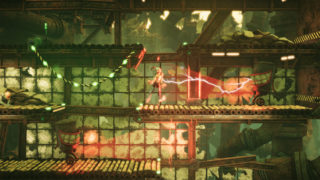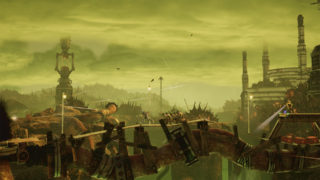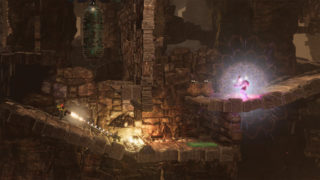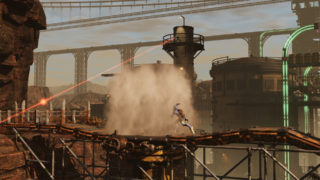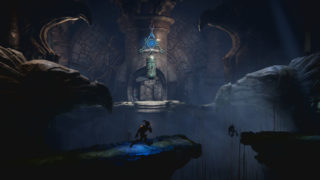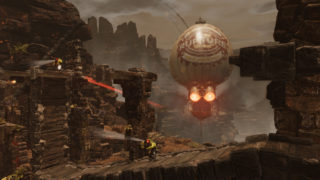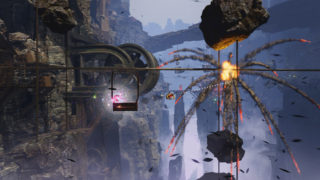Oddworld Soulstorm review: Plenty of smart ideas, but few of them gel
Lorne Lanning’s platforming remake is an ambitious brew let down by disobedient controls and AI
- Creative Director
- Lorne Lanning
- Key Credits
- Josh Gabriel (Composer)

Oddworld’s hero, Abe, always was an ungainly creature. Awkward and clumsy, like most members of his enslaved Mudokon race. To escape servitude, he has to rely on stealth, makeshift tools and his one extraordinary power to telepathically possess his enemies.
Those are all very useful, but Abe lives in a world that expects him to be far more reactive and agile than he is. It’s a world packed with hazards and enemies that can end him instantly, punishing every small false move. And when you’re as ungainly as Abe, small false moves are never far away.
Expect to die a lot in Oddworld: Soulstorm, then. And expect to feel that much of the time it was because Abe couldn’t quite execute the precise sequence of actions that the situation demanded. Or because there was a deadly detail you couldn’t quite see. Or because something or someone acted in a way they weren’t supposed to.
To a degree, Abe’s efforts have always been tests of patience, right back to his PS1 days. But here it’s more severe. An added layer of complexity in control, perspective and the whims of friends and foes alike makes everything that bit less reliable and trickier than it should be.
Which is unfortunate, because developer Oddworld Inhabitants has stuffed an assortment of smart ideas into the course of Soulstorm’s substantial campaign. This is a puzzle platform game with strong emphasis on both sides of that equation, but also plenty more.
True, the first few levels are quite restrictive and a little too plain in their brown cave setting. But from there on, you’re given an increasingly expansive range of tools and tricks to play with, amongst some intricately designed locations that play with perspective and switch pace between the pensive and the action-packed.
The basics will be familiar to series veterans. Oddworld is a land made of iron and rock, mines and industrial cities, webbed together by systems of pistons, levers, elevators and monorails. Its comic-book capitalist overlords and their squid-like Slig minions will do anything to stop you freeing the Mudokons who toil away in the depths.
Much of the time it’s not only about your own survival, but getting your buddies to safety. You don’t have to rescue them, but you might feel guilty if you don’t, and you’ll need to get the majority out to access the game’s full ending. Besides, some of the most neatly designed rooms are those that have you trying to guide Mudokons through traps or napping enemies towards escape portals.
Stealth is often compulsory, since defence mechanisms in some areas hamper your ability to mind control the slig guards. Avoid the short enemy vision cones while holding down a sneak button to creep on tip-toes or jump with caution and you should be fine. Alerted foes shoot on sight, but stay hidden and they soon forget anything was wrong.
“The first few levels are quite restrictive and a little too plain in their brown cave setting. But from there on, you’re given an increasingly expansive range of tools and tricks to play with, amongst some intricately designed locations that play with perspective and switch pace between the pensive and the action-packed.”
With all the caution, there’s real catharsis when you do get to let loose and turn the tables on your oppressors. Your chant ability sees you possess a nearby soldier, who you can then send on a brief rampage, before his mates realise what’s going on and gun him down. Repeat until the area is clear.
The pendulum swings between naked vulnerability and explosive offence are one of the aces up Soulstorm’s sleeve, and they’re augmented by a new focus on scavenging supplies and crafting. There’s a nod here to that other Oddworld classic, Stranger’s Wrath, with its creative use of ‘live’ ammo. Early on you’ll be throwing bottles of flammable brew to burn through wooden walls (and the occasional hapless slig). Before long you’re assembling stun mines, rubber ball missiles and explosive soda cans.
Sometimes there’s an infinite supply of certain ingredients nearby, but you increasingly depend on whatever you can scrape out of bins or under-stocked vending machines, and decide how best to use it. Is it worth using a valuable battery now to make a mine, or should you save it and hope to gather the parts for a flamethrower? You might even hand some projectiles to your buddies to back you up in combat.

All of which is to say, there’s a sizeable spread of tools to work with in Soulstorm, and the game works hard at teasing out their full potentials. This isn’t merely a series of prescribed platform puzzles. It mixes its switch-based linear progression with a call for ingenuity, and adds in a host of optional items to find and things to destroy in each level.
Yet that freeform complexity is also what gets in the way of a rewarding experience. With so many objects, systems and NPCs bumping together, events rarely play out quite as they should. So many things you rely on working every single time simply don’t.
Abe himself is one culprit, as he struggles to harmonise with the surrounding environment. Jumping and grabbing a ledge or monkey bar is oddly difficult. A single ‘interact’ button has too many context-sensitive purposes, from tying up enemies to rummaging through bins or disarming mines, which overlap in confusing ways.
“The pendulum swings between naked vulnerability and explosive offence are one of the aces up Soulstorm’s sleeve, and they’re augmented by a new focus on scavenging supplies and crafting.”
And as impressive as everything looks, it’s not always visibly clear what’s in play. Visual cues can be indistinct and the camera tends to hover at a just-off side view, making it tricky to align yourself with switches or direct your throws with accuracy. We spent some 20 minutes trying to blow up a mech boss on a train, simply because we couldn’t quite judge where to aim the killer shot.
In situations like this, you’re also being pelted by endless missiles that force you to figure things out on the fly. Even early in the game, there’s a sequence where you have to take cover from infrared sniper scopes probing from the background, while making tricky jumps and avoiding foreground enemies under a rain of bombs. Then just when you think you’ve found a safe spot, you get hit after all.
The sense of vagueness is only exacerbated when it comes to saving your friends. The AI struggles to cope with your attempts to herd them around, creating some anomalous results. You tell your gang to hide in a row of lockers, but one refuses, standing exposed as a slig returns on patrol. You try to guide them under a crushing platform, only for one to dawdle and get squashed. We’ve even had a whole group disappear without trace when a checkpoint reloaded.
Soulstorm isn’t supposed to be easy, unlike many of today’s more gentle puzzle platform games, but too much of its challenge comes from struggling with demands for precision when the game doesn’t give you the quality of equipment you need for the job. Yes, dropping the difficulty down relieves some of the symptoms, but the root issues remain.

The biggest frustrations come in sequences where you have to fight off waves of enemies as hundreds of Mudokons climb to freedom in the background. What should be an exercise in your mastery of the skills and gear at your disposal becomes nothing but stress. Seeing and hearing your defenceless comrades being gunned down for your repeated failure is miserable.
Soulstorm’s big side objective of rescuing sufficient Mudokons to get a good ‘quarma’ rating on each level is therefore more hassle than it’s worth. It requires everyone to behave in a predictable manner, and that’s just not something they can promise. After a while, the only guarantee is that their inanely repetitive ‘comedy’ chatter will increasingly grind your gears.
It’s not only the Mudokons who won’t do as they’re told either. Some enemies have problems returning to patrol routes once they’ve been alerted. We’ve also had issues with the game crashing from the PS5’s rest mode, and on a few occasions been forced to reload checkpoints due to bugs (the publisher acknowledged these in advance and is working on fixes).
Still, there is something endearing about Abe. His adventures are big and imaginative. And it’s hard not to root for him, with his sorrowful eyes and underdog demeanour. Who doesn’t like a little guy fighting back against oppression? We just wish he was a bit more up to the job.
Oddworld: Soulstorm is an advancement on previous games in the series in every way, but that’s both its biggest achievement and the source of its problems. The complexity and variety in its locations is commendable, as is the wealth of tools at your disposal for dealing with its many tricks and foes. But many of its systems don’t work together reliably, or don’t respond with the necessary speed, which leaves an experience that’s rarely as entertaining as it promises to be.
- Level design is intricate and varied
- Possessing your enemies is as cathartic as ever
- Crafting adds new options and depth
- Lack of precision in controls and visual cues
- Friendly AI behaves erratically



